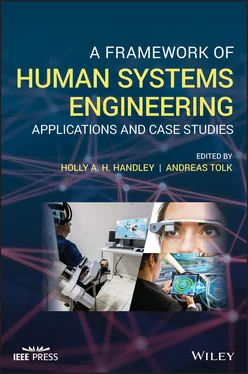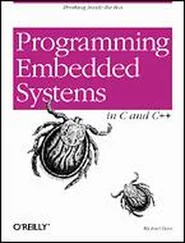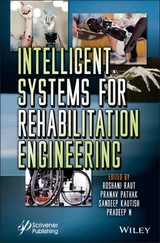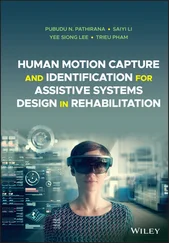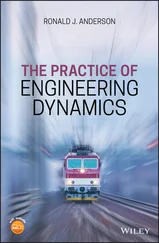A Framework of Human Systems Engineering
Здесь есть возможность читать онлайн «A Framework of Human Systems Engineering» — ознакомительный отрывок электронной книги совершенно бесплатно, а после прочтения отрывка купить полную версию. В некоторых случаях можно слушать аудио, скачать через торрент в формате fb2 и присутствует краткое содержание. Жанр: unrecognised, на английском языке. Описание произведения, (предисловие) а так же отзывы посетителей доступны на портале библиотеки ЛибКат.
- Название:A Framework of Human Systems Engineering
- Автор:
- Жанр:
- Год:неизвестен
- ISBN:нет данных
- Рейтинг книги:4 / 5. Голосов: 1
-
Избранное:Добавить в избранное
- Отзывы:
-
Ваша оценка:
- 80
- 1
- 2
- 3
- 4
- 5
A Framework of Human Systems Engineering: краткое содержание, описание и аннотация
Предлагаем к чтению аннотацию, описание, краткое содержание или предисловие (зависит от того, что написал сам автор книги «A Framework of Human Systems Engineering»). Если вы не нашли необходимую информацию о книге — напишите в комментариях, мы постараемся отыскать её.
A Framework of Human Systems Engineering
Applications and Case Studies
A Framework of Human Systems Engineering: Applications and Case Studies
A Framework of Human Systems Engineering — читать онлайн ознакомительный отрывок
Ниже представлен текст книги, разбитый по страницам. Система сохранения места последней прочитанной страницы, позволяет с удобством читать онлайн бесплатно книгу «A Framework of Human Systems Engineering», без необходимости каждый раз заново искать на чём Вы остановились. Поставьте закладку, и сможете в любой момент перейти на страницу, на которой закончили чтение.
Интервал:
Закладка:
Table of Contents
1 Cover
2 Title Page
3 Copyright Page
4 Dedication Page
5 Editor Biographies
6 Contributors List
7 Foreword
8 Preface
9 Section 1: Sociotechnical System Types 1 Introduction to the Human Systems Engineering Framework 1.1 Introduction 1.2 Human‐Centered Disciplines 1.3 Human Systems Engineering 1.4 Development of the HSE Framework 1.5 HSE Applications 1.6 Conclusion References 2 Human Interface Considerations for Situational Awareness 2.1 Introduction 2.2 Situational Awareness: A Global Challenge 2.3 Putting Situational Awareness in Context: First Responders 2.4 Deep Dive on Human Interface Considerations 2.5 Putting Human Interface Considerations in Context: Safe Cities 2.6 Human Interface Considerations for Privacy‐Aware SA Reference 3 Utilizing Artificial Intelligence to Make Systems Engineering More Human * 3.1 Introduction 3.2 Changing Business Needs Drive Changes in Systems Engineering 3.3 Epoch 4: Delivering Capabilities in the Sociotechnical Ecosystem 3.4 The Artificial Intelligence Opportunity for Building Sociotechnical Systems 3.5 Using AI to Track and Interpret Temporal Sociotechnical Measures 3.6 AI in Systems Engineering Frameworks 3.7 AI in Sociotechnical Network Models 3.8 AI‐Based Digital Twins 3.9 Discussion 3.10 Case Study 3.11 Systems Engineering Sociotechnical Modeling Approach 3.12 Results 3.13 Summary References 4 Life Learning of Smart Autonomous Systems for Meaningful Human‐Autonomy Teaming 4.1 Introduction 4.2 Trust in Successful Teaming 4.3 Meaningful Human‐Autonomy Teaming 4.4 Systematic Taxonomy for Iterative Through‐Life Learning of SAS 4.5 Ensuring Successful SAS 4.6 Developing Case Study: Airborne Shepherding SAS 4.7 Conclusion Acknowledgment References
10 Section 2: Domain Deep Dives 5 Modeling the Evolution of Organizational Systems for the Digital Transformation of Heavy Rail 5.1 Introduction 5.2 Organizational System Evolution 5.3 Model‐Based Systems Engineering 5.4 Modeling Approach for the Development of OCMM 5.5 Implementation 5.6 Case Study: Digital Transformation in the Rail Industry 5.7 OCMM Reception 5.8 Summary and Conclusions References 6 Human Systems Integration in the Space Exploration Systems Engineering Life Cycle 6.1 Introduction 6.2 Spacecraft History 6.3 in the NASA Systems Engineering Process 6.4 Mission Challenges 6.5 Conclusions References 7 Aerospace Human Systems IntegrationEvolution over the Last 40 Years 7.1 Introduction 7.2 Evolution of Aviation: A Human Systems Integration Perspective 7.3 Evolution with Respect to Models, Human Roles, and Disciplines 7.4 From Rigid Automation to Flexible Autonomy 7.5 How Software Took the Lead on Hardware 7.6 Toward a Human‐Centered Systemic Framework 7.7 Conclusion and Perspectives References
11 Section 3: Focus on Training and Skill Sets 8 Building a Socio‐cognitive Evaluation Framework to Develop Enhanced Aviation Training Concepts for Gen Y and Gen Z Pilot Trainees 8.1 Introduction 8.2 Virtual Technologies in Aviation 8.3 Human Systems Engineering Challenges 8.4 Potential Applications Beyond Aviation Training 8.5 Looking Forward Acknowledgement References 9 Improving Enterprise Resilience by Evaluating Training System ArchitectureMethod Selection for Australian Defense 9.1 Introduction 9.2 Defense Training System 9.3 Concept of Resilience in the Academic Literature 9.4 DTS Case Study Methodology 9.5 Research Findings and Future Directions References 10 Integrating New Technology into the Complex System of Air Combat Training * 10.1 Introduction 10.2 Method 10.3 Results and Discussion 10.4 Conclusion Acknowledgments References
12 Section 4: Considering Human Characteristics 11 Engineering a Trustworthy Private Blockchain for Operational Risk ManagementA Rapid Human Data Engineering Approach Based on Human Systems Engineering 11.1 Introduction 11.2 Human Systems Engineering and Human Data Engineering 11.3 Human‐Centered System Design 11.4 Practical Issues Leading to Large Complex Blockchain System Development 11.5 Framework for Rapid Human Systems–Human Data Engineering 11.6 Human Systems Engineering for Trustworthy Blockchain 11.7 From Human System Interaction to Human Data Interaction 11.8 Future Work for Trust in Human Systems Engineering 11.9 Conclusion Acknowledgment References 12 Light’s Properties and Power in Facilitating Organizational Change 12.1 Introduction 12.2 Implicit Properties and a Mathematical Model of Light 12.3 Materialization of Light 12.4 Leveraging Light to Bring About Organizational Change 12.5 Summary and Conclusion References
13 Section 5: From the Field 13 Observations of Real‐Time Control Room Simulation 13.1 Introduction 13.2 Future General‐Purpose Simulators 13.3 Operators 13.4 Data 13.5 Measurement 13.6 Conclusion Disclaimer References 14 A Research Agenda for Human Systems Engineering 14.1 The State of Human Systems Engineering 14.2 Recommendations from the Chapter Contributions 14.3 Uniting the Human Systems Engineering Stakeholders 14.4 Summary Disclaimer References
14 Index
15 End User License Agreement
List of Tables
1 Chapter 3 Table 3.1 Case study comparative analysis.
2 Chapter 4 Table 4.1 Key elements of meaningful human control (MHC). Table 4.2 Technology readiness level (TRL). Table 4.3 Proposed SAS cognitive competence levels. Table 4.4 Proposed SAS readiness levels.Table 4.5 Human–robot interaction roles.Table 4.6 Situation awareness levels.
3 Chapter 5Table 5.1 Organizational evolution example.Table 5.2 Mapping the user portals to information libraries.Table 5.3 Model groupings in metamodel.Table 5.4 Demonstrator scope.Table 5.5 Task‐based SA assessment (pre‐ETCS example).Table 5.6 Summary of SA factors (operate train example).Table 5.7 Workload by variables (ATMS example).Table 5.8 Workload assessment by process (excerpt).
4 Chapter 9Table 9.1 RAN training Force intent, associated actions, and measures of achi...Table 9.2 Key elements of resilience definition and their associated vocabula...Table 9.3 Six “increments” of resilience concept.Table 9.4 Attributes commonly associated with the concept of resilience.Table 9.5 Resilience attributes as proposed in a single source.Table 9.6 Examples of the nine resilience attributes' definitions.Table 9.7 Resilience triggers.Table 9.8 Resilience attributes and their manifestations.Table 9.9 DTS resilience questions for training system specialist.
5 Chapter 10Table 10.1 Aircraft flown by participants.Table 10.2 Naval air combat expert profiles.Table 10.3 Results of the assessment of potential LVC training hazards using ...
List of Illustrations
1 Chapter 1 Figure 1.1 HSE original framework. Figure 1.2 HSE framework as an index for the case studies.
2 Chapter 3 Figure 3.1 Systems engineering evolution. Figure 3.2 A conceptual architecture for Epoch 4. Figure 3.3 A taxonomy of artificial intelligence. Figure 3.4 Risk taxonomy. Figure 3.5 Example project social network. Figure 3.6 Project information ecosystem. Figure 3.7 BBN example element. Figure 3.8 Case study project social network. Figure 3.9 Confidence vs. stability. Figure 3.10 Case study project events. Figure 3.11 Belief alignment and stability results for case study.
3 Chapter 4Figure 4.1 Technology evolution for successful M‐HAT in Sky Shepherd researc...Figure 4.2 Sky Shepherd pilot sets up a DJI Mavic II Enterprise Duo ready fo...Figure 4.3 A flock of Dorper sheep ( Ovis aries ) responding to the presence o...
4 Chapter 5Figure 5.1 Organizational system evolution.Figure 5.2 OCMM development approach.Figure 5.3 OCMM metamodel (excerpt).Figure 5.4 Example system introductions.Figure 5.5 ETCS level 2 system structure.Figure 5.6 Operate train (ETCS L2 onboard operation modes).Figure 5.7 Partial activity diagram for ETCS L2 stop at signal.Figure 5.8 Role allocation (RASCI).Figure 5.9 RASCI role structure for operate train process under ETCS.Figure 5.10 OCMM model of situation awareness.Figure 5.11 Situational awareness assessment (operate train example).
Читать дальшеИнтервал:
Закладка:
Похожие книги на «A Framework of Human Systems Engineering»
Представляем Вашему вниманию похожие книги на «A Framework of Human Systems Engineering» списком для выбора. Мы отобрали схожую по названию и смыслу литературу в надежде предоставить читателям больше вариантов отыскать новые, интересные, ещё непрочитанные произведения.
Обсуждение, отзывы о книге «A Framework of Human Systems Engineering» и просто собственные мнения читателей. Оставьте ваши комментарии, напишите, что Вы думаете о произведении, его смысле или главных героях. Укажите что конкретно понравилось, а что нет, и почему Вы так считаете.
